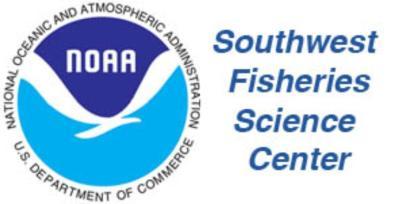Summary of Results
The Adrift in the California Current survey was intended to provide additional baseline data on marine mammals and the marine soundscape to inform management of offshore renewable resource development in the California Current. In addition to conducting data collection efforts in and around the Morro Bay, Humboldt, and Oregon WEAs, we also analyzed archived data from previous large scale acoustic surveys.
The first phase of Adrift was initiated in June 2020 off Northern California, with a special focus on the Humboldt WEA. We partnered with NOAA Sanctuaries to provide additional sampling off San Francisco between late Spring and late Summer. Initial deployments were delayed until August 2021 due to the COVID-19 pandemic. The second phase extended this effort to the Morro Bay WEA offshore Central California in 2021. In 2022 we initiated a pilot study to examine the potential for extending this study northward to include offshore Oregon. Data collection efforts were severely limited due to the COVID-19 pandemic as well as inclement weather and oceanographic conditions aggravated by La Niña. Despite these limitations, we deployed 90 drifting recorders in our four study areas for a total of 8,736 recording hours.
Prior to this study, NOAA had successfully deployed drifting acoustic recorders during two large-scale surveys and developed methods to estimate beaked whale density for the larger California Current region. Southwest Fisheries Science Center in partnership with BOEM’s Pacific Region is currently conducting an additional large-scale survey with drifting acoustic recorders (Pacific Marine Assessment Partnership for Protected Species – PacMAPPS II/CalCurCEAS).
While we have been successful using drifting recorders during these large-scale surveys during the late post-upwelling season, we encountered significant challenges in using them during other oceanographic seasons. There were multiple cases of equipment and data loss, especially during the initial deployments. Losses were due to a variety of reasons, including inclement weather, strong currents, and recorder failures. We mitigated these problems through modifying components and altering survey methods. A number of gear modifications were made to improve robustness and to decrease self-noise that interfered with recording quality.
Drifting acoustic recorders provide a low-cost alternative to traditional PAM systems and they can provide additional geographic and temporal resolution in remote offshore areas. Clustered drifting recorders provide an opportunity to improve our understanding of the spatial and temporal variability of the contributors to the soundscape. Preliminary results suggest that clustered drifting recorders can be used to reduce the possible range of possible source location for sound sources (see Modeling Habitat Use) and can provide information on the spatial variation in soundscape (see Spatial Variation in Noise). Drifting recorders were deployed in clusters of 4 drifting recorders in Humboldt and Oregon study areas, and in clusters of 8 in the Morro Bay Study area. In some cases, drifting recorders in close proximity to each other followed dramatically different drift trajectories.
